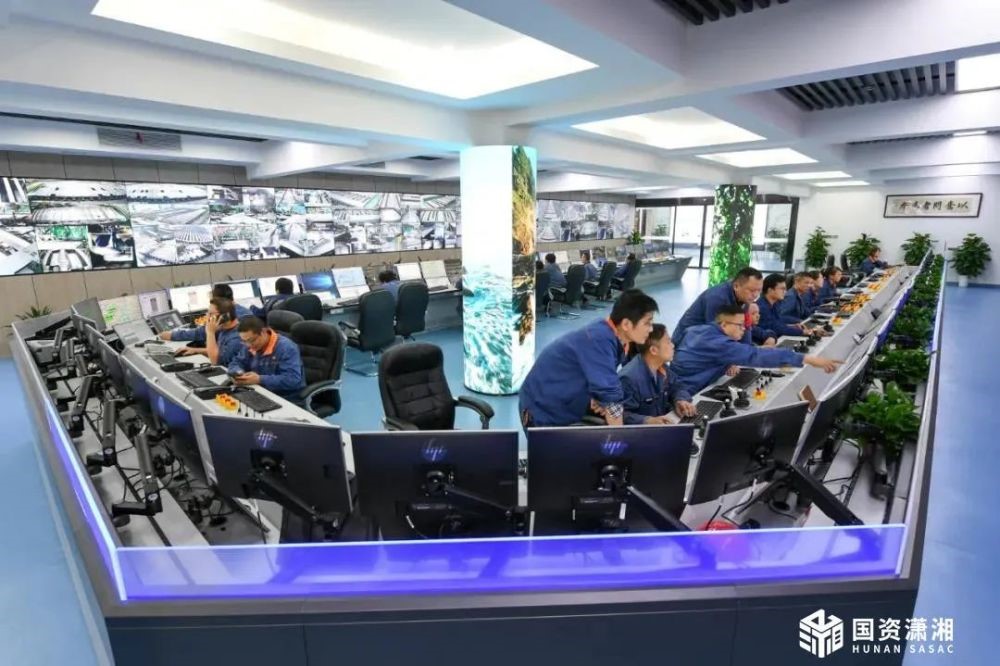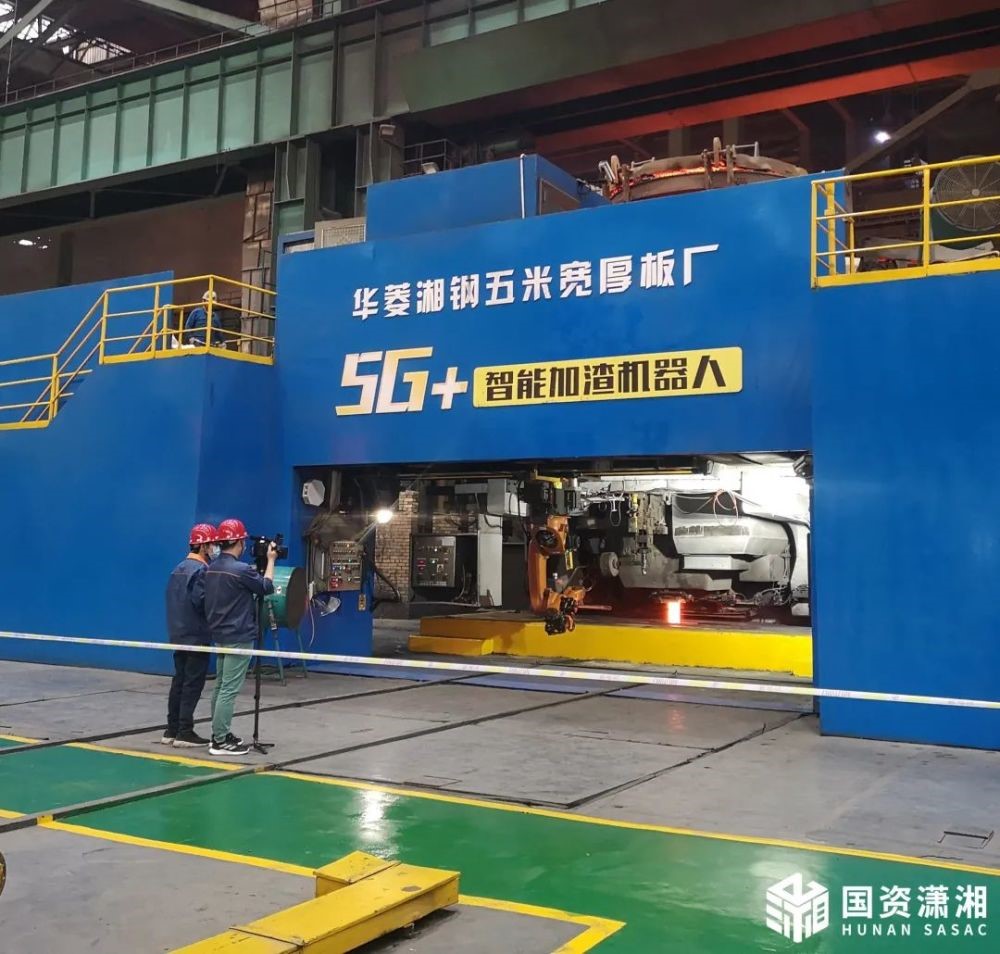5G energizes China’s iron and steel industry
The integration of 5G technology into the industrial Internet has helped improve the quality and efficiency of China’s traditional iron and steel industry by accelerating the application of products with big data-based functions such as remote control, collaborative operation and troubleshooting in recent years.

Workers monitor steel production remotely at the central control room of a plant under Hunan Valin Xiangtan Iron and Steel Co., Ltd. in central China’s Hunan province. (Photo/State-owned Assets Supervision and Administration Commission of Hunan Provincial People’s Government)
At the steelmaking zone of a wide and heavy plate plant run by Hunan Valin Xiangtan Iron and Steel Co., Ltd. (Xiangtan Steel) in Xiangtan, central China’s Hunan province, four large electromagnetic bridge cranes were busy attracting scrap steel with a weight of several tons and then moving it accurately onto a truck.
The bridge cranes were remotely controlled by Tan Bin, who sat in a spacious central control room and accomplished loading and unloading tasks by simply pulling or pushing levers and pressing buttons in front of a screen.
“Work was so much tougher when I had to stay in the operator’s cab of bridge crane before remote control was possible,” Tan recalled.
“The operator’s cab was noisy, and would sometimes be infiltrated by dust. So we needed to wear masks all the time in work,” the operator added.
Taking advantage of the ultra-high reliability and ultra-low latency of new technologies, the plant realizes the ultra-high-speed uploading and downloading of data, thus allowing workers to control the equipment accurately and remotely, according to He Wei, deputy director of the production equipment department of Xiangtan Steel, who said that the integration of 5G into bridge cranes has greatly improved operators’ work efficiency.
Shougang Jingtang United Iron and Steel Co., Ltd. in Tangshan city, north China’s Hebei province, has set up a management system that can monitor in real time the operation of the four main devices of coke ovens, an essential facility for iron and steel companies, namely coke pusher, coke barrier vehicle, coke quenching vehicle and coal charging car. These machines playing different roles are closely connected with each other and form an organic and unified whole through the transmission of signals.
Besides real-time monitoring of the four main devices of coke ovens, the management system enables man-machine dialogues, allowing workers to give orders to machines.
The four devices can send their operating data to the central control room, explained Ding Hongqi, a staff member at the coking department of the iron and steel company in Tangshan.

A slag adding robot is busy performing its tasks at a plant under Hunan Valin Xiangtan Iron and Steel Co., Ltd. in central China’s Hunan province. (Photo/State-owned Assets Supervision and Administration Commission of Hunan Provincial People’s Government)
However, due to low bandwidth, image transmission was often troubled by network latency in the past, Ding said, adding that the problem has been solved after the company employed 5G technology.
As a typical process manufacturing industry, the steel industry is characterized by continuous production process and requires timely transmission of large amounts of information in a complex environment, something that the company’s former information system can no longer sustain. Therefore, the industry is in urgent need of intelligent transformation.
In 2019, the coking department of the company applied 5G in the remote operation of the four devices to realize their intelligent and synchronous connection, making the remote operation of the equipment more reliable, efficient and safer.
“We have realized the stable, safe and fast transmission of images,” said Ding, adding that after analysis and logical judgment, the central control room gives corresponding instructions to the programmable logic controllers of the four devices, thus ensuring their collaboration.
Since 2019, the company has promoted the transformation and upgrading of steel manufacturing technologies and equipment by integrating 5G into the industrial Internet, increasing its production efficiency by about 15 percent.
After upgrading key basic equipment by combining 5G and the industrial Internet, Ansteel Information Industry Co., Ltd. based in Dalian, northeast China’s Liaoning province, has enabled data collected by sensors installed in equipment, such as temperature, vibration, pressure, and flow, to be transmitted to a cloud platform in real time to realize real-time monitoring, diagnosis and troubleshooting for equipment with the help of artificial intelligence (AI) and big data analysis, according to Liu Jiawei, chief researcher of the company.
Since the application of 5G technology and the industrial Internet, data on the current of motors on each one of the roller beds of the company’s 1,780-milimeter hot strip mill production line has been collected in real time. Whenever an abnormality occurs, the equipment automatically sounds alarm and locates the fault accurately.
“In the past, after spotting scratches on products caused by motor failure, we needed to examine over 400 roller beds of the production line one by one, which took 30 minutes to one hour. Now we can determine the problems basically within 10 minutes,” said Ma Liang, a worker at the production line.
While the maintenance efficiency has improved and the downtime of equipment shortened, the percentage of rejects and degraded products has dropped from about 7 percent to 3.8 percent, which has helped the company cut costs, Ma added.
Besides breakdown recovery, the application of 5G technology and Industrial Internet has also enabled active maintenance of equipment.
Thanks to relevant applications, the experience of veteran workers has been converted into data models, which help achieve scientific maintenance and full lifecycle management of equipment based on data analysis, Liu said.
For the 1,780-milimeter hot strip mill production line, the number of emergency shutdowns and troubleshooting has decreased by 20 percent and the operating rate of equipment increased by 5 percent after the transformation of the production line, Liu pointed out.
Photos
Related Stories
- “5G+industrial Internet” upgrades China’s steel industry for a new era
- Expanding 5G network coverage helps remote villages tap thriving e-commerce market in SW China’s Guizhou
- Deer Show | Hypersonic? Or Hyperpanic?
- “5G+industrial Internet” upgrades manufacturing of China
- 5G technology transforms medical emergency service in SW China's Chongqing
- China's 5G phone shipments top 70 pct in Jan.-Sept.
Copyright © 2021 People's Daily Online. All Rights Reserved.










